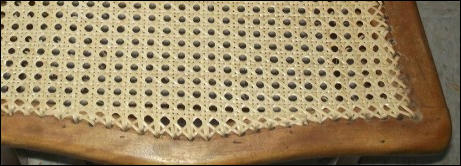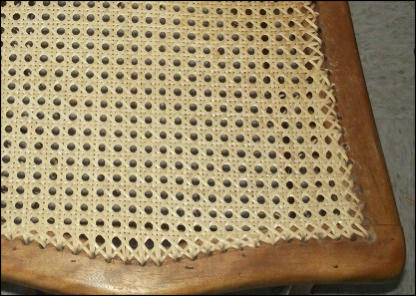© Heritage Chair Caning - Specialists in chair caning and furniture restoration in Tunbridge Wells, Ashford and throughout the South East
Chair caning | Furniture restoration & repair | Re-upholstery | Rush seating | Tunbridge Wells | Rye | Tenterden | Ashford | Sussex | Surrey | Kent

The chair recaning process
The first step in caning a chair is to
determine what type of cane is
needed.
Other chairs integrate woven cane, which means that there are small holes around the seat of the
chair for the cane to be woven in and out of. It is not advisable to attempt to convert a sheet caned
chair to a woven cane chair, or vice versa, as doing so may damage the chair's soundness and value
as an antique.
Some chairs, especially those made after the 1860s,
were designed to be caned with sheet cane, which is
cane that has been machine woven and is sold in
sheets. Chairs designed for sheet caning have a groove
around the seat for the edge of the sheet cane to be
tucked into.
Sheet Caning
Woven Cane
Heritage Chair Caning provides expert chair caning in Tenterden, Tunbridge Wells, Ashford
and throughout the South East.
Strand cane is the material most commonly used to cane a chair, and it is derived from rattan. Other
materials used to cane a chair include rushes, some types of wood, paper rush, seagrass, leather,
and pretty much any other strong and flexible material. Strand cane comes in varying sizes:
common, medium, fine, fine-fine, and superfine.
Types of Cane

All major credit cards accepted
07538 533374
© Heritage Chair Caning
Chair caning | Furniture restoration & repair | Re-upholstery
Rush seating | Tunbridge Wells | Tenterden | Ashford

The chair recaning process
The first step in caning a chair is to determine
what type of cane is needed.
Other chairs integrate woven cane, which means
that there are small holes around the seat of the
chair for the cane to be woven in and out of. It is
not advisable to attempt to convert a sheet
caned chair to a woven cane chair, or vice versa,
as doing so may damage the chair's soundness
and value as an antique.
Some chairs, especially those made after the
1860s, were designed to be caned with sheet
cane, which is cane that has been machine woven
and is sold in sheets. Chairs designed for sheet
caning have a groove around the seat for the
edge of the sheet cane to be tucked into.
Sheet Caning
Woven Cane
Heritage Chair Caning provides expert chair
caning in Tenterden, Tunbridge Wells, Ashford
and throughout the South East.
Strand cane is the material most commonly used
to cane a chair, and it is derived from rattan.
Other materials used to cane a chair include
rushes, some types of wood, paper rush,
seagrass, leather, and pretty much any other
strong and flexible material. Strand cane comes
in varying sizes: common, medium, fine, fine-fine,
and superfine.
Types of Cane
Specialists in chair caning and furniture restoration in
Tunbridge Wells, Ashford & throughout the South East

© Heritage Chair Caning - Specialists in chair caning and furniture restoration in Tunbridge Wells, Ashford and throughout the South East
Chair caning | Furniture restoration & repair | Re-upholstery | Rush seating | Tunbridge Wells | Rye | Tenterden | Ashford | Sussex | Surrey | Kent
The chair recaning process

The first step in caning a chair is to determine what
type of cane is needed.
Other chairs integrate woven cane, which means that there are small holes around the seat of the chair for the cane to be
woven in and out of. It is not advisable to attempt to convert a sheet caned chair to a woven cane chair, or vice versa, as doing
so may damage the chair's soundness and value as an antique.
Some chairs, especially those made after the 1860s, were designed to be caned
with sheet cane, which is cane that has been machine woven and is sold in
sheets. Chairs designed for sheet caning have a groove around the seat for the
edge of the sheet cane to be tucked into.
Sheet Caning
Woven Cane
Heritage Chair Caning provides expert chair caning in Tenterden, Tunbridge Wells, Ashford and throughout the South
East.
Strand cane is the material most commonly used to cane a chair, and it is derived from rattan. Other materials used to cane a
chair include rushes, some types of wood, paper rush, seagrass, leather, and pretty much any other strong and flexible
material. Strand cane comes in varying sizes: common, medium, fine, fine-fine, and superfine.
Types of Cane

07538 533374
All major credit cards accepted
07538 533374





































